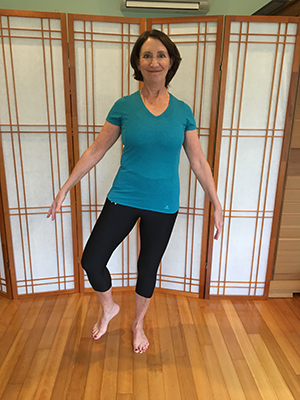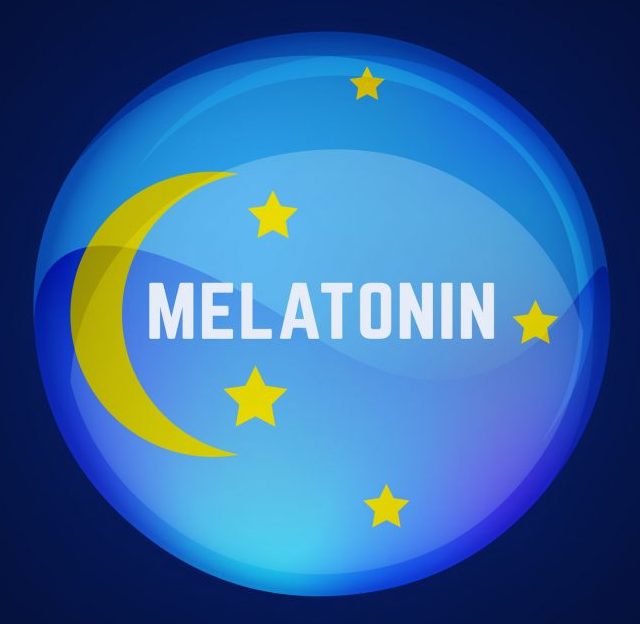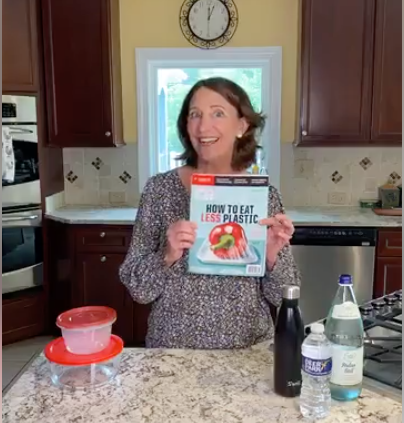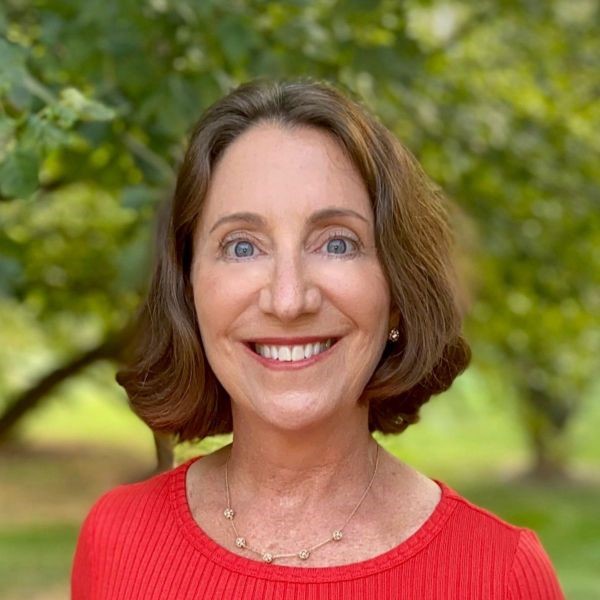
by Susan Brady | Jul 8, 2020 | Healthy aging
Did you know that 1/3 of Americans over the age of 65 fall at least once a year? Taking a tumble might not seem like a big deal, but a simple fall can lead to bruises, broken bones, sprained joints, and head injuries that can impact your mobility and function from days to years.
There is no doubt that the risk of falling increases with age, but not just old age! Your balance begins to decline when you are around 40-50 years old. So even a simple misstep, a stumble in the dark or not paying attention while climbing the stairs can leave anyone of us falling to the ground. However, you can lower your risk of falls by training your balance system. Just like there are exercises that strength your muscles and heart, and there are also exercises that can improve your balance.
Even though the body’s process for maintaining balance is very complex, there are 3 main systems that work together to keep you upright.
- Visual system: your vision helps you see where your body is in relationship to your environment
- Vestibular system: Inside your inner ear you have vestibular structures that inform the brain about changes in the head positions and body movements.
- Proprioception system: Your muscles, tendons and joints have special sensors called proprioceptors which help provide your brain with information on movement and position of your body parts.
Using the feedback of these 3 systems, the brain sends messages to your muscles to make adjustments to your body position in order to maintain balance and coordination. If any of these systems isn’t working correctly, it can increase your risk of falling. Other risk factors that contribute to falling are poor posture and muscle weakness, especially weakness in the muscles of the trunk, hips and ankles.
An effective balance training program includes exercises that integrates all these systems. By challenging these systems, along with strengthening your muscles and improving posture, you can improve your balance and decrease your risk of falling.
So how do you integrate these systems into an
effective balance training program?
- Combine challenge with safety: Perform exercises near a wall, counter, desk, or firm chair so you have something to grab onto if you lose your balance…which you should! If the exercise isn’t challenging, it isn’t progressing your balance.
- Lose the shoes: First you need to ditch the shoes and perform balance activities in bare feet. Your feet are covered with proprioceptors and provide abundant feedback to your brain as to your body’s position. Barefoot balance activities also help to strengthen the muscles of the foot and ankle which will add to your stability.
- Add movement for maximum benefit: Moving your head while performing balance activities can stimulate the vestibular organs and adding in arm and leg movements improves reaction time and coordination of all three systems.
- Soften up the surface: changing the surface from firm floorings to standing on a pillow, a soft mat or a balance board will further challenge balance and strength simultaneously. Performing balance exercises on an unstable surface provides even greater proprioceptive training and strengthens muscle of the trunk and lower legs.
Static Single Leg Balance:
- On a firm surface, standing tall with your abdominal muscles tight
- First stand on your dominant leg with your other leg lifted and slightly bent at the hip and knee and positioned away from the standing leg
- Work up to holding this position for 20 seconds on each leg
- Challenge yourself by trying to hold this position with your eyes closed
Once you get good with the static single leg balance, progress to dynamic stability exercise to enhance the challenge to your visual, vestibular and proprioception systems.
Dynamic Balance exercises
While standing on one leg with good posture and abdominal muscles tight, move your arms back and forth in a running motion. Perform for 20-30 seconds.
Incorporate larger arm movements as if you are swimming the freestyle, then reverse arm direction and swim the backstroke.
Perform each for 20-30 seconds, switch legs.
Further engage your vestibular and visual system by adding in head turns. While standing on one leg, slowly and gently turn your head side to side at the rate of 1 movement per second. Head movements should be in a comfortable range and not cause neck pain.
Perform for 10-20 seconds
Next you can add lower leg movements. While standing on one leg, reach the other leg out to the front, side and then the back, initially touching your toe for balance if needed. You can increase the challenge of this exercise by performing a min squat with the leg movements. With this movement you can also add in arm and head movements as above.



If you are unable to stand safely on one leg, start by performing all the above exercises with your feet together and then progress to performing the exercises in a staggered stance.
As we move through life, our balance is challenged on a daily basis…whether you know it or not. The change in surfaces that we walk on, finding our way to the bathroom in the dark of night, turning your head to look to see if a car is coming as you walk across a street or a parking lot. Incorporating balance training into your daily exercise program will help you meet daily balance challenges, improve your stability and prevent falls. If you want to prevent fractures, we need to prevent falls!
Contact me to find out more ways you can protect your bones from fracturing! Susan@nurturedbones.com

by Susan Brady | Jun 24, 2020 | Sleep & stress reduction
You have probably read about the use of melatonin as a natural sleep aid, but did you know that melatonin may also play an important role in slowing down the aging process?
Melatonin is a hormone that regulates our circadian rhythm, or our sleep-wake cycle. It is secreted by a small gland in the brain, called the pineal gland. The pineal gland has only one function and that is to produce copious amounts of melatonin at night. In the morning, as the sun rises and our eyes are bathed in light, the pineal gland turns off and stops producing melatonin. The natural production of melatonin in response to darkness plays a crucial role in making us feel drowsy and promoting restorative sleep. Additionally, melatonin appears to have several other beneficial roles as well, and may even guard against age-related diseases and decline.
Melatonin has powerful anti-inflammatory and antioxidant effects. It is well known that the process of aging and many of our chronic degenerative diseases are the results of systemic inflammation and free radical damage to our cells and tissues.
Benefits of Melatonin Beyond Sleep:
- Free radical scavenger. Melatonin’s antioxidant effects protect against free radicals that damage tissue and play a role in heart disease, cancer, diabetes, and other degenerative diseases. Melatonin also effectively fights inflammation, another root cause of many diseases.
- Immune function. Melatonin can activate T-cells and cytokines, which help to fight off foreign invaders or pathogens.
- Anti-cancer properties. There is some evidence that melatonin, through its antioxidant, anti-inflammatory, and systemic hormonal effects, can prevent cancer from occurring or induce cancer cell death if it does occur. Several studies have found a credible link between night light exposure, reducing melatonin levels, and breast cancer.
- Protects the blood-brain barrier. The blood-brain barrier is a special barrier that protects the brain from toxins and pathogens circulating in the blood. Melatonin may have the potential in preventing damage to the blood-brain barrier and thereby decrease the risk of developing neurodegenerative diseases like Alzheimer’s as we age.
- Bone density. Melatonin positively affects bone density by both suppressing bone loss and promoting new bone formation.
However, many studies have shown that melatonin levels decrease with age. Not only does this leave unable to repair our tissues from daily stress but it may also play a role in the aging process and developing age-related diseases.
But before you run to the store to pick up a melatonin supplement, first try some natural ways to boost your melatonin levels at night.
8 Natural ways to support healthy melatonin levels:
- Get morning sunshine. Morning sunlight directly into the eyes deactivates the pineal gland, suppresses the production of melatonin, and helps to “set” the natural rhythm of melatonin.
- Avoid light at night. Light is a direct inhibitor to the production of melatonin. Therefore, exposure to light at night, especially the blue light emitted from electronic devices, can prevent the secretion of melatonin making it more difficult for you to fall and stay asleep. So be sure to limit the use of smartphones, pads, and computers at night.
- Escape the EMFs or electromagnetic fields. EMFs are not a new phenomenon, but we are getting a steady increase in exposure with all the advancing technologies. Studies have shown that exposure to EMFs can influence our circadian rhythm by interfering with melatonin secretion. It is best to turn off your phone at night while you are sleeping. However, if it is your primary lifeline to your family, place it at least 15 feet away from your bed.
- Sleep in a dark environment. A dark environment ensures a good production of melatonin throughout the night. So be sure to turn off all lights, the TV, and any device that may be emitting light.
- Eat foods rich in melatonin, tryptophan, and magnesium. Foods rich in melatonin include pistachios, almonds, walnuts, tart cherries, Golgi berries, and tomatoes. Because the amino acid tryptophan is needed in the production of melatonin, eating foods rich in tryptophan such as turkey and chicken can raise melatonin levels. Magnesium-rich foods like leafy greens, nuts and seeds and legumes also naturally boost your melatonin levels. If you do snack in the evenings, snack on foods such as pistachios, pumpkin seeds, almonds, or walnuts.
- Limit foods that decrease the secretion of melatonin. Meat and dairy have been shown to decrease the production of melatonin along with caffeine and alcohol.
- Take a hot Epsom salt bath. The warm water will have a relaxing effect on the body and the magnesium in the Epsom salt will aid to naturally boost melatonin levels.
- Maintain a consistent sleep-wake schedule. Going to bed at the same time every night and waking up at the same time every morning will help to maintain a healthy melatonin rhythm.
Certainly, supplementing with melatonin is also an option, but because melatonin can have side effects and may interact with certain nutrients, herbs, and pharmaceuticals medications, it is best to consult a health care practitioner before taking melatonin.
Want to further explore the use of melatonin as a sleep aid or to as an adjunct to healthy aging? Schedule a 30-minute supplement review and together we can determine if supplementing with melatonin is right for you.
Or email me at susan@urturedbones.com

by Susan Brady | Jun 19, 2020 | Healthy aging
 I picked up Consumer Reports magazine this week and the headlines on the front cover reads:
I picked up Consumer Reports magazine this week and the headlines on the front cover reads:
“HOW TO EAT LESS PLASTIC”
The article highlights that, on average, we are consuming a credit cards worth of plastic a day!
Last time I looked, plastic was not considered an essential nutrient in our diet!
So how is it that we are consuming, on average, 5 grams of plastic a week? What are the effects on our body? How can we minimize our consumption of these plastics?
Researchers are finding tiny bits of plastic, called microplastic, in our food, our drinking water and even in the air we breathe. Although plastics appear to be stable, over time they break down into tiny fragments, smaller than 5 mm, and end up in our environment and then in our body. In a small but world-wide study (1), scientists found nine different types of plastic in the stool of every person who participated. It is likely that microplastics are in all of us.
This shouldn’t be surprising since plastics are ubiquitous in our modern day lifestyle. Plastics are in almost every product we use on a daily basis. Obvious sources such as water bottles, containers and plastic bags, and less obvious sources including clothing, personal care products, toothbrushes, laundry and dishwasher pods, and the case on your smartphone. These plastics, no doubt, improve our lives in many ways, but they can also cause environmental pollution and pose potential risks to our health.
So what are the health risks of these plastics?
- They can get it into the tissues of our body and cause systemic inflammation
- There is some evidence that they can cross the membrane that protects our brain from foreign bodies in our bloodstream
- They can be a magnet for other toxins and make it harder for our bodies to eliminate toxins
- They expose us to harmful chemicals like bisphenols, phthalates, styrene and polychlorinated biphenyls (PCBs)
Bisphenols and phthalates are known endocrine disruptors and interfere with our hormones. Our hormones are essential to every system of our body, from our reproductive and immune systems to our musculoskeletal system. These chemicals have even been shown to interfere with bone metabolism and trigger bone cell death in animals studies.
Styrene, a chemical found in plastic and food packaging, has been linked to nervous system problems, hearing loss and cancer.
Microplastics in our body can also expose us to PCB’s, which have been linked to various cancers, a weakened immune system, and reproductive problems.
Now as alarming as this might seem, I want you to take a deep breath, because there are some simple steps you can take to reduce the consumption of these plastics.
Minimizing our exposure to microplastics:
- Limit the use of plastic water bottles. A study out of the State University of NY found that bottled water contained nearly twice as many pieces of microplastic than tap water. I know a lot of people are weary about drinking tap water as well, so buy a good water filter and fill up your own bottles. Glass or stainless steel bottles are the safest.
- Switch to glass or ceramic food storage containers. Storing foods or beverages in plastic containers for long periods will cause the accumulation of microplastics in the foods. If using plastic, check the number printed on the bottom of the container. The plastic containers that have #2, #4 and #5 printed at the bottom, are considered safer for food storage. Containers with a #1, are a single-use container and meant to be used only once and they recycled.
- Never heat up plastics. Heating up food in a plastic container will cause the plastic and leach chemicals into your food. The same for plastic water bottles and plastic wraps. If you are going to heat something up in the microwave, you a glass or ceramic dish and cover with a paper towel, wax paper or parchment paper.
- When shopping, use paper bags, or your own reusable shopping bags. Best is to try to limit the amount of food that you buy that is packed in plastic wrap. Consider purchasing mesh bags to put your produce in when shopping.
- Choose natural personal care products. Take a look at your toothpaste, facial scrubs and soaps. If they list polyethylene in the ingredients, those are microplastics.
- Keep a clean house. Believe it or not, dust particles in our homes have been shown to have a high concentration of microplastics and their associated chemicals. Dusting and vacuuming regularly can prevent the buildup of dust in our homes.
- Keep your body healthy. By eating clean, exercising, getting good quality sleep and keeping your stress in check, you can support your detoxification systems which will allow enhance your body’s ability to eliminate microplastics and their chemicals.
These are just a few ways you can start to reduce the consumption of microplastics, however, with all the plastics in our world, we are never going to get down to a zero exposure. What I don’t want is for you to drive yourself crazy with worry, because that is not good for you either! My advice is that on a daily basis, do what you can do to reduce the amount of plastics in your life.
References:
1. Schwabl, P. et al, 2018. Assessment of microplastic concentrations in human stool – Preliminary results of a prospective study, Presented at UEG Week 2018 Vienna, October 24, 2018

by Susan Brady | May 6, 2020 | Healthy aging
When life is in chaos, your home is your safe haven. The stay at home orders have extended in most states way longer than most of us ever expected! Although some states are beginning to lift closure restrictions on non-essential business, it will still be months before life gets back to normal. Additionally, I have heard from many of you that you are going to be very cautious about re-entry into the real world!
I want to thank you all for your heart felt responses as to how you have created a Home Health Haven for yourself! I know there are many ongoing frustrations, but I am amazed by the resilience, creativity and perseverance many of you have shown.
Here are a few comments on coping:
- “It has helped to limit my time watching the news and reading about all the craziness going on in the world”
- “I have enjoyed getting outside in nature and taking long walks, it really helps”
- “I have done well with establishing a routine and it has kept me on track with my health goals”
- “I am not only surviving, but becoming healthier!”
- “It’s fun to be on a health kick with my 22 year old son and I appreciate that he does all the shopping and rarely goes off the list”
- “I’ve enjoyed doing Chair Yoga on Amazon Prime with my best high school girlfriend and spending a few minutes after each session catching up”
- “I have enjoyed doing group mediations on Zoom”
- “I enjoy my Zoom visits with my family”
- “I have developed a prayer and meditation routine everyday”
- “I am doing workout programs online until the gym opens up again”
- “Since I can’t go to the gym, I am using a weight vest and walking more and doing body weight exercises”
- “I have found peace spending time out in my garden”
Here are few comments about ongoing frustrations:
- “Uncertainty is really frustrating”
- “Having a hard time keeping up with work and since I’m working from home, it’s easy to work extra hours”
- “I really miss my family”
- “I miss being able to hold my granddaughter”
- “It’s hard for me to be on the sidelines and not out there helping with the pandemic”
- “It will be a great day when church opens up again”
Healthy Habits I have established that I will continue:
- “Keeping the alcohol, dairy, sugar and junk food out of the house so I don’t consume it! “
- “I intend to continue to watch less TV and be more in the moment”
- “I am going to continue to connect with my distant family through Zoom so we can all “see” each other more often”
- “I like getting up and exercising first thing in the morning, instead of after work at the end of the day. I feel more energized and more focused at work”
As the quarantine lingers, either self imposed or through mandation, I have decided to switch my mode of communication and connect with you through weekly FaceBook Lives. Facebook Lives can allow me to be more interactive and dynamic!
For the next month I will continue not only to talk about the realities of taking care of yourself and your bones when you’re stuck at home but you can also join me for my kitchen exercise routine as well as get a peek into favorite recipes along with my decadent downfalls. Yup, none of us are perfect!
Moving forward, what topics would be most interesting to you? Help me to help you!
First FB Live will be tomorrow, Wednesday, May 6th at 12 noon, Eastern. During tomorrow’s 5 minute Live I’m going to show you the exercise I rely on everyday to keep my back strong and pain free.
Follow me on Facebook and join me for my FB Live Kick Off at 12 noon on Wednesday, May 6th.
Follow Nurtured Bones on FaceBook by Clicking Here!
Susan Brady
is a Physical Therapist,
Nutrition Consultant and
Doctor of Integrative Medicine.
She has been treating women with osteoporosis for over 30 years and is dedicated to helping people achieve
lasting good health and vitality.
Want to learn more about how you can improve your bone health? Contact me for a free 15 minute phone consult to learn more about the BONES Method™ and how it can help you achieve strong, healthy bones for life!

by Susan Brady | Apr 30, 2020 | Healthy aging
When I started with my “Creating a Home Health Haven” blog back on March 23rd, my goal was to provide support and encouragement to my community during a time of turmoil. We were hurled into a situation none of us had ever experienced. As world leaders focused on how to protect the population from getting sick, as an integrative health care practitioner, I wanted to focus on how we can stay well: physically, mentally, emotionally and spiritually.
Our homes, where most merely ate a good meal and rested their heads, have become our everything; our place of rest and security, our place of work, worship and socialization, our place of exercise, learning and creativity. My purpose was to help you create a space that could meet all of these needs that are so essential to staying healthy and happy. In taking this on, I learned a lot and found that I helped myself and my family create a home health haven too. Today, I want to share some things I’ve learned in the last month since sheltering in our home.
- I learned that I am much more emotionally balanced and resilient when I keep a daily schedule. Waking, exercising, eating, and going to bed at the same time everyday has given me some sense of control over my life during a time of extreme uncertainty. The sense of losing control can leave you feeling fearful and powerless. What I have realized is that, though I may not have external control of what is happening in the world outside my home, I do have control over what happens inside my home. Sticking to a regime of daily activities has helped me stay physically and mentally fit.
- I need to wear shoes to be productive. Don’t laugh! Even though I dressed every morning for my work day, if I remained in bare feet or merely donned socks or slippers, I inevitably struggled to focus. It also doesn’t seem to matter what I am wearing… jeans, sweatshirt, slacks, sweater…just whether or not my feet are secured with shoes! Wearing shoes, for some reason, puts me in an active state of mind. Who knew feet and brain are connected?
- I have learned to appreciate technology more than ever. I have always viewed technology as bittersweet. However, I have become a champion of technology during this crisis because it has made it so easy to stay connected to our loved ones and friends. Although there is nothing that replaces connecting in person, having the ability to Skype/Zoom/Facetime can truly bring people together. I have been able to connect with friends and family, living both miles away and only a few miles down the road, through virtual game nights, birthday parties and happy hours. Although it baffles me why it took a crisis to more actively nurture these connections, I am grateful that we have been able to actually grow closer despite having to stay further apart.
- Despite creating a healthy haven for myself indoors, being home bound solidified how much I truly need fresh air, sunshine and nature for mental clarity, positive spirit and overall well-being. Honestly, people aren’t meant to spend the whole day inside drenched in artificial lighting and sitting in a chair breathing circulated air. A few years ago, I wrote a post about the healing powers of nature and the science behind “forest bathing.” When researching this Japanese practice, I learned that trees and plants emit compounds called phytoncides which help us reduce stress and boost our immune system. We all intuitively know that nature is therapeutic, but it’s nice to have science back it up!
- I learned that I can get by with only using 4 squares of toilet paper with every visit to the bathroom – maybe that is too much information! Although I am sensitive about using too much toilet paper on the head of a boat, I never thought that I would have to count my daily squares in my own home…and add it to every shopping list!
- Writing these blogs highlighted the fact that when we help others, we help ourselves. Though my intent was to encourage each and every one of you to stay healthy and strong while sheltering at home, your feedback and responses were so heartening that they lifted my spirits and sustained my health as well. So I am humbled and grateful for having a such a supportive audience.
Here we are at the end of April, 5 weeks since I started my posts. Many states have started to re-open, but the majority continue to ask people to remain at home for at least another month. I have heard from many however, that it is going to be a long time until they feel comfortable again leaving their home. Therefore, continuing to find ways to connect and stay physically and mentally fit is going to be imperative.
What have you learned about yourself throughout this process? What steps have you taken to maintain your health and well-being? What things have you enjoyed about spending more time at home? What has been your biggest frustration? What new health habits are going to continue moving forward? And, do you also get more done when you have shoes on?
Please share…I would love to hear from you! I’m hoping to compile and share the tips and techniques we each have incorporated into our “new normal” lives so we can all continue adapt and support each other.
Simply send me an email and share your thoughts and experiences.
Susan Brady
is a Physical Therapist,
Nutrition Consultant and
Doctor of Integrative Medicine.
She has been treating women with osteoporosis for over 30 years and is dedicated to helping people achieve lasting good health and vitality.
Want to learn more about how you can improve your bone health? Contact me for a free 15 minute phone consult to learn more about the BONES Method™ and how it can help you achieve strong, healthy bones for life!















